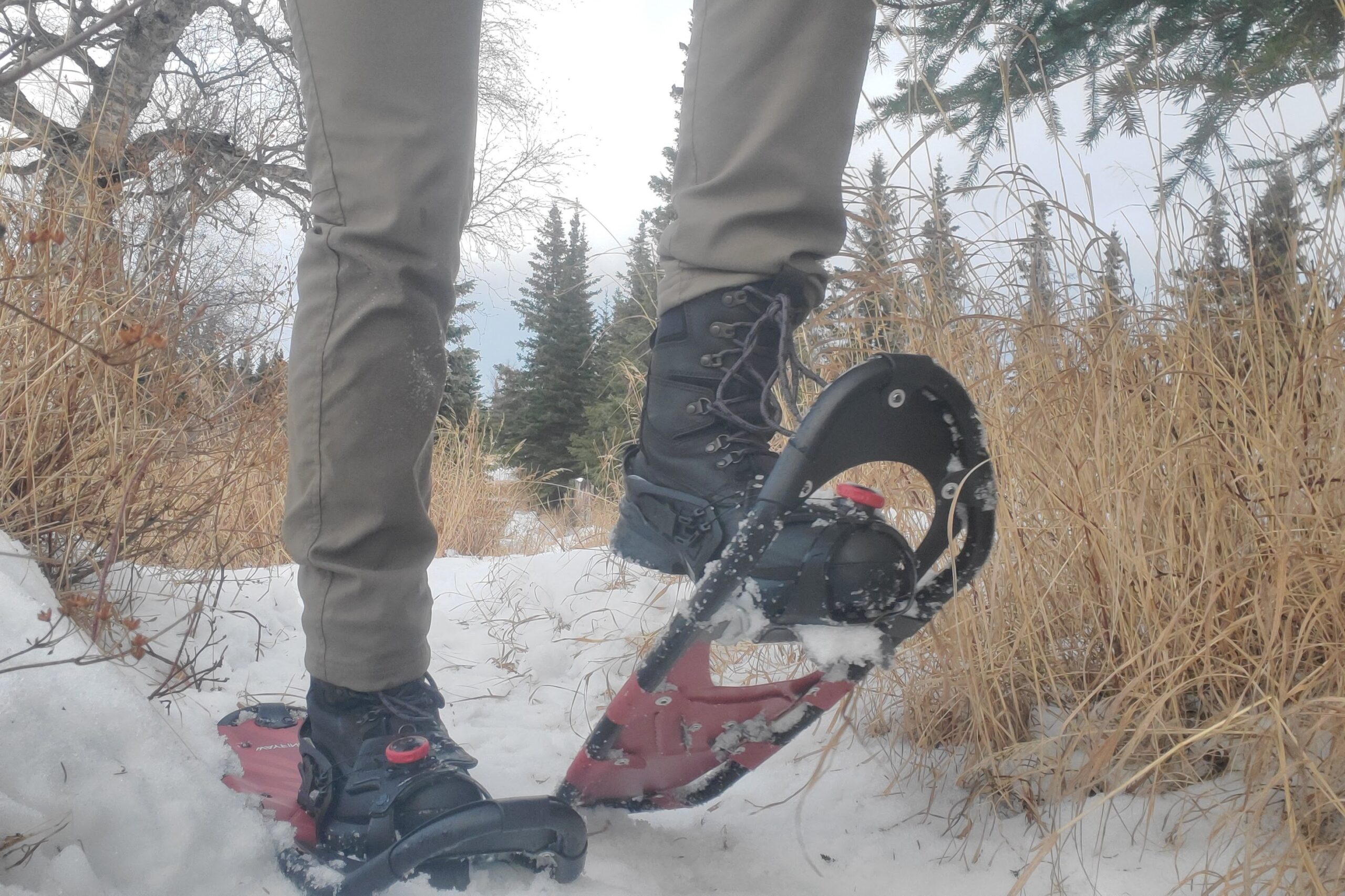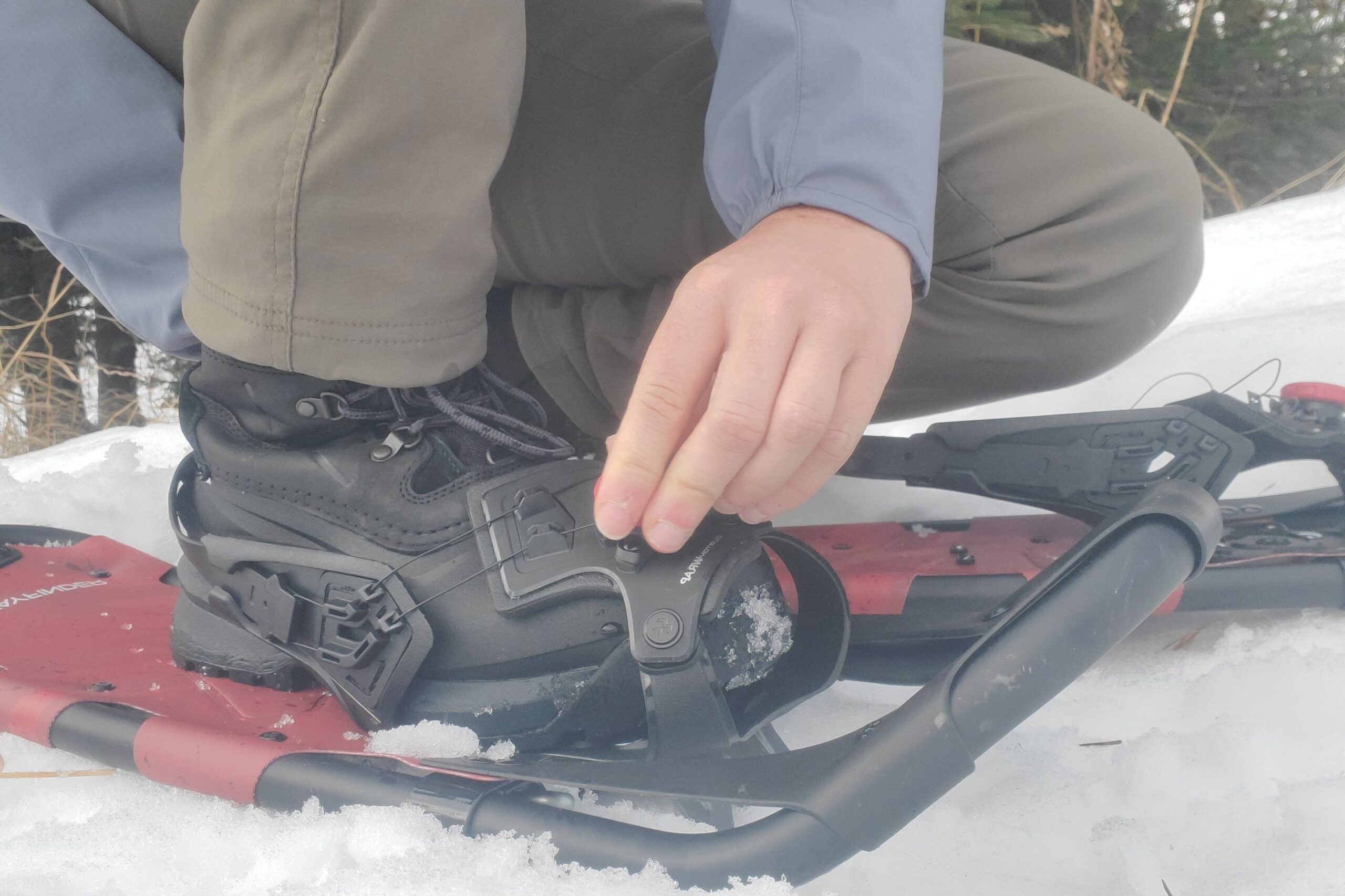
Tubbs Wayfinder Snowshoe Review | CleverHiker
Bottom Line
The Tubbs Wayfinder stands out in our lineup of best snowshoes as a high-performing, entry-level option. It features a traditionally styled frame of tube aluminum with nylon decking that is both lightweight and durable. We enjoyed them best on trails and in light powder. Thanks to its tapered design almost resembling a teardrop, a natural stance is comfortable and there is no overlapping of the snowshoes while walking. A rockered profile from toe to heel allows for an easy gate on a variety of slopes and surfaces.
We are big fans of the Boa closure system. Micro adjustments are easy even while wearing gloves, thanks to the simple twist of the dial. Getting the snowshoes on and off takes a second or two. We love the Boa for its simplicity and security.
Without any significant traction aids, the Wayfinders quickly met their match on steep and slippery slopes. Also, while walking in wet snow, they balled snow under the forefoot. Because of this, they performed best on rolling trails without excessively deep snow. The Tubbs Wayfinder is the perfect option for someone wanting one snowshoe for more casual outings.
Quick Specs

Tubbs Wayfinder
Comfortable Snowshoes with Great Bindings
CleverHiker Rating:
4.4/5
Price:
$200
Weight (Pair):
3 lb. 6 oz.(25 in.)
Length:
21″, 25”, 30”, 36″
Materials:
Aluminum, Nytex nylon
Pros
- Option to lengthen tails
- Shape helps maintain a natural gait
- Heel lifts
Cons
- Less floatation in deep snow
- Small teeth on traction claws
The Tubbs Wayfinder snowshoe (Men’s / Women’s) is an excellent choice for entry-level adventurers seeking versatility, comfort, and ease of use without breaking the bank. Featuring a lightweight aluminum frame and durable Nytex nylon decking, the Wayfinder is designed for rolling trails and light powder conditions. Its tapered, teardrop-like design promotes a natural stride, while the rockered profile ensures smooth movement across various terrains.
A standout feature is the innovative boa binding system, which simplifies securing and adjusting the snowshoes. With a quick twist of the dial, you can achieve a snug fit that stays secure on your foot. Micro-adjustments and loosening are quick and easy, all while wearing gloves.
The Wayfinder loves packed trails and gentle inclines. They are less suited for steep or icy slopes due to their limited traction. The short traction points provide adequate grip on moderate terrain but can struggle on more challenging surfaces. Additionally, flotation is best in moderate snow depths less than twelve inches deep, as the tapered design offers less surface area than some competitors.
The Tubbs Wayfinder balances high-quality materials with a user-friendly design, making it a top choice for casual outings. Whether you’re exploring groomed trails or venturing into light powder, this snowshoe delivers comfort and convenience for beginners and recreational users alike.
Full Review: Tubbs Wayfinder

Flotation
During our testing, we took the Tubbs Wayfinders on a variety of trails and conditions, from packed and groomed to deep powder. Testing these in the foothills of the Chugach Mountains of Alaska, these snowshoes to be most at home on packed trails and those with six inches or less of powder snow.
The tapered profile of these snowshoes provides less surface area than others we tested. Combined with a large opening through the toe of the snowshoes, these snowshoes sink further than others tested and will not be our first choice for taking into deep snow or for off-trail adventures where others have not broken in the trail.

Traction
When walking on rolling terrain and packed trails, the traction offered by the Tubbs Wayfinder was more than adequate. Small yet sharp traction points in the midfoot, and the heel bites solidly into the snow under pressure. Their low profile made for easy walking without tripping. We enjoyed this pair best on packed trails.
However, when taking these up steep slopes, it quickly became evident that these are not the snowshoes to take on anything steep and deep. When testing these on a mellow slope before transitioning to steep, they started to slip at about twenty degrees, requiring the use of hands to make it to the top of the hill.
With only a small v-shape of traction protruding less than an inch under the heels, walking downhill was especially slippery, and we frequently slid down the hill. The tails of these snowshoes have no additional attraction aid, so walking down anything steeper than a small hill quickly turned into spicy “skiing”. They are not our top picks for steep terrain, but they are great for rolling hills and flats.

Walkability
We were immediately impressed with the ease of walking while wearing the Tubbs Wayfinder. Their tapered design from toe to tail almost resembles a teardrop and allows for a natural stance while wearing them. The snowshoes feature a slightly rockered profile, allowing for a smooth and easy gait for rolling terrain.
When walking in early winter wet snow, these snowshoes balled up under the toe and midfoot more than others tested. Whether it was the shape of the traction points or the material used, these snowshoes collected snow and required frequent clearing.
With only two small screw heads under the heel for traction on the surface of the deck, we found our heels sliding back and forth on the slippery nylon decking. We wished for some sort of stomp pad to grip into the soles of our boots for a more secure step.

Ease of Use
The Boa binding system on the Tubbs Wayfinder is one of the best we tested. The cable system runs from the heels to a plate that tightens securely across the top of the foot, keeping all components of the binding secure in one continuous system.
We loved how easy it is to slip on and off these snowshoes. Tightening them is equally as easy, even with gloves on. The ratcheting Boa dial allows for micro adjustments and quick adjustments on the fly. The heel of the binding also comes with snaps with labeled sizes to easily set the length of the strap for a customized and secure fit.
When using these in hilly terrain, we wished for a heel riser. While this doesn’t negatively impact the experience on most excursions, it might have improved their ability to load the shoe evenly and saved us from some slips and slides.

Should You Buy the Tubbs Wayfinder?
The Tubbs Wayfinder is best suited for those who spend most of their time on packed trails and rolling terrain. While capable of handling shin-deep powder, these snowshoes are not the ones for snow much deeper than six inches. Their low traction works great for rolling trails, but anything steep or deep immediately overwhelms these snowshoes, and they quickly lose traction.
With an ergonomic shape, the Tubbs Wayfinde is comfortable and easy to walk in. Its Boa system is top-of-class for adjustability and ease of use. This snowshoe is perfect for the casual or entry-level snowshoer who is not looking to spend a lot of money and wants a snowshoe that can take multiple conditions and surfaces in stride.

What Other Snowshoes Should You Consider?
MSR Evo Trail Review – Another trail-oriented snowshoe, the MSR EVO Trail comes with the lightweight maneuverability of a trail snowshoe but with traction that can handle the steeps.
Retrospec Drifter Review – Similar in shape, the Retrospec Drifter offers solid flotation but better traction and a durable ratchet-style closure system.
XtremPro Outdoors Snowshoe Review – If price is your number one concern, then the XtremPro Outdoors Snowshoe offers one of the lowest prices of any snowshoe we tested.




